Fraud and error in the benefit system Financial Year Ending (FYE) 2023
Published 11 May 2023
Applies to England, Scotland and Wales
1. Introduction
The Department for Work and Pensions (DWP) pays welfare benefits to around 22.4 million people. ‘Fraud and error in the benefit system’ estimates how much money the department incorrectly pays, either by paying people too much benefit – overpayments – or by not paying enough benefit – underpayments. This is calculated as a percentage of the total amount of benefit paid by the department – expenditure. These percentages are referred to as overpayment or underpayment rates throughout this publication. The proportion of benefit claims that are overpaid or underpaid is also reported.
The rates found are then applied to the benefit expenditure for the Financial Year Ending (FYE) 2023 to estimate the monetary amount of fraud and error. The benefit expenditure figures used are consistent with Spring Budget 2023.
Overpayments and underpayments happen because of Fraud, Claimant Error and Official Error (processing errors or delays by DWP, a local authority, or His Majesty’s Revenue and Customs (HMRC)).
Estimates in this publication relate to benefit claims sampled between September 2021 and October 2022. See Appendix 1 or Appendix 2 for specific time periods relating to each reviewed benefit.
Analysis is undertaken to provide assurance that the sampling period is representative of the financial year. However, actions taken by the department within the financial year may not always be fully reflected within the statistics.
The benefit reviews cover a period impacted by the coronavirus (COVID-19) pandemic.
Next Edition: May 2024
2. Main stories
The total rate of benefit expenditure overpaid in FYE 2023 was 3.6% (£8.3bn), compared with 4.0% (£8.7bn) in FYE 2022 which was the highest recorded level of overpayments.
The total rate of benefit expenditure underpaid in FYE 2023 was 1.4% (£3.3bn), the highest recorded level, compared with 1.2% (£2.6bn) in FYE 2022.

3. What you need to know
About this publication
This publication contains estimates of the levels of fraud and error in the benefit system. The main measure is the percentage of benefit expenditure that is overpaid or underpaid, referred to as overpayment or underpayment rates. This is also expressed as a monetary value in pounds.
DWP measures fraud and error to understand the levels, trends and reasons behind it. This understanding supports decision making on what actions DWP can take to reduce the level of fraud and error in the benefit system. The National Audit Office considers the amount of fraud and error when they audit DWP’s accounts each year.
These estimates relate to the levels of fraud and error in the benefit system in Great Britain. They are underpinned by reviews of benefit claimants in England, Wales and Scotland. The benefit expenditure figures used in this publication also include overseas residents who are receiving United Kingdom benefits, except Financial Assistance Scheme payments which also cover Northern Ireland. All other benefit expenditure on residents of Northern Ireland is the responsibility of the Northern Ireland Executive. The benefit expenditure figures do not include amounts devolved to the Scottish Government (which totalled £3.7 billion in FYE 2023).
Published tables and data
The figures in this publication are a selection from the Reference tables. The tables contain further breakdowns of the estimates presented in this publication by different characteristics, with time series data going back to FYE 2006 for some benefits.
The reference tables have been reordered due to a new measure being published for the first time this year. This means that some table numbers have changed from previous publications. The cover sheet in the reference tables provides more information on the changes.
How fraud and error is measured
A sample of benefit claims is randomly selected from DWP’s administrative systems (around 13,600 were sampled for FYE 2023, or 0.06% of all benefit claims). DWP’s Performance Measurement team look at the data held on the administrative systems and then contact claimants to arrange a review.
Claimants are asked to provide evidence such as identity documents, bank account details and other information that could affect their benefit claim, as part of the review.
The claim is assessed to determine whether the benefit award is correct or not. The amount of money the claim is wrong by is calculated if the claim is incorrect. Errors on the claim are classified as one of the following:
-
Fraud
-
Claimant Error
-
Official Error
Read more about the definitions of Fraud, Claimant Error and Official Error later in this section.
Any errors identified are classified further into error reasons, which explain why the claim is incorrect. Simplified descriptions of the error reasons are given in this publication. A more detailed glossary of the error reasons can be found in Appendix 3 of the background information document.
Fraud and error measures – rates and monetary values
The monetary value of fraud and error is calculated using the rate of expenditure overpaid or underpaid that was found in the sample for benefits measured this year:
Monetary value overpaid or underpaid = (rate of expenditure overpaid or underpaid) x (benefit expenditure)
It is possible for the rate of expenditure overpaid or underpaid to decrease whilst the monetary value increases and vice versa. This happens because of changes in benefit expenditure between the years compared.
For example: The total rate of overpayments on Housing Benefit (HB) was 5.5% in FYE 2023, compared with 5.3% in FYE 2022. The associated monetary value of overpayments was £820m in FYE 2023, compared with £880m in FYE 2022. The rate of overpayments was higher in FYE 2023, whilst the monetary value was lower. This is because of the lower expenditure on HB in FYE 2023.
The monetary values are not adjusted for inflation.
It is recommended that the rates are used when comparing over time for these reasons, rather than the monetary amounts.
Fraud and error measures – proportion of claims with fraud or an error
The way we report on the proportion of claims with an overpayment or underpayment has been extended. In this publication, the proportion of claims paid the incorrect amount is reported for the first time (reference table 11). We continue to report the proportion of claims with an overpayment error or an underpayment error (reference tables 12 and 13).
These measures are different because a claim can have both an overpayment error or Fraud and an underpayment error for different error reasons. For example: a claimant is receiving a benefit payment of £100. Two errors are found on the claim. The first is an overpayment error totalling £50. The second is an underpayment error totalling £20. The correct benefit payment for the claimant is £70 (£100 original payment minus £50 overpaid plus £20 underpaid). The claimant is overpaid by £30 after considering all errors.
Such claims are included in both the proportion of claims with an overpayment error or Fraud (reference table 12) and the proportion of claims with an underpayment error (reference table 13). Claims are reported as either overpaid or underpaid within reference table 11, depending on the outcome of their combined overpayment and underpayment errors. In the example above, the claim would be reported as having been overpaid in reference table 11.
The measures are calculated as follows.
Proportion of claims with an overpayment or underpayment (reference tables 12 and 13)
Proportion of claims with Fraud or an overpayment error = (number of claims in the sample with at least one Fraud or at least one overpayment error) / (number of claims in the sample)
Proportion of claims with an underpayment error = (number of claims in the sample with at least one underpayment error) / (number of claims in the sample)
Since the same claim can be included in both the proportion of claims with an overpayment error or Fraud and the proportion of claims with an underpayment error, these figures cannot be summed together to obtain the total proportion of claims paid incorrectly.
Proportion of claims paid the incorrect amount (reference table 11)
Proportion of claims overpaid = (number of claims in the sample ultimately overpaid) / (number of claims in the sample)
Proportion of claims underpaid = (number of claims in the sample ultimately underpaid) / (number of claims in the sample)
These figures can be summed together to obtain the total proportion of claims paid incorrectly.
De Minimis reporting
For all measures relating to the proportion of claims with Fraud or an error, we have introduced a de minimis approach across all benefits. This means that all errors of 10p or less are reported separately to the headline measures of the proportion of claims with Fraud or an error. The State Pension section in this publication and section 2 of the background information document provide further information.
Methodology changes and revisions
Several changes have been made to the methodology used to produce estimates of fraud and error this year. Estimates for FYE 2022 have been revised using the updated methodology and are included in this publication to allow for comparison with FYE 2023.
Further details on the methodology changes and revisions are available in this publication, in the State Pension and Housing Benefit sections, as well as in section 2 of the background information document.
Statistical significance and confidence intervals
These estimates are based on a sample of benefit claims receiving a monetary payment. Choosing another sample may have given different estimates. The figures quoted in this publication are the central estimates, which are calculated from the sample. A range around the central estimates, called a confidence interval, is also calculated. This expresses the uncertainty associated with the central estimate. A simplified view is that the confidence interval provides a range of plausible values within which the true value for the population lies. See section 5 of the background information document for further detail.
Changes between years are noted as being statistically significant when the difference observed is likely to reflect a true change at the population level, rather than random variation between the samples. Any statistically significant changes between the years being compared are specified in this publication.
Definitions of Fraud, Claimant Error and Official Error
In this publication incorrect claims are classified as follows.
Fraud
Claims where all three of the following conditions apply:
-
the conditions for receipt of benefit, or the rate of benefit in payment, are not being met
-
the claimant can reasonably be expected to be aware of the effect on their entitlement
-
benefit payment stops or reduces as a result of the review
Claimant Error
The claimant has provided inaccurate or incomplete information, or failed to report a change in their circumstances, but there is no evidence of fraudulent intent on the claimant’s part.
Official Error
The benefit has been paid incorrectly due to a failure to act, a delay or a mistaken assessment by DWP, a local authority or HMRC, to which no one outside of that department has materially contributed, regardless of whether the business unit has processed the information.
4. Total estimates of fraud and error across all benefit expenditure
Total benefit expenditure increased from £215.8bn in FYE 2022 to £233.8bn in FYE 2023. This was an increase of £18.0bn (8.3%) which was due to:
-
State Pension expenditure increasing by £5.2bn (5.0%), from £104.5bn in FYE 2022 to £109.7bn in FYE 2023
-
Universal Credit expenditure increasing by £3.0bn (7.5%), from £40.4bn in FYE 2022 to £43.4bn in FYE 2023
-
Personal Independence Payment expenditure increasing by £2.6bn (17.3%), from £15.1bn in FYE 2022 to £17.7bn in FYE 2023
-
Cost of Living Payments expenditure of £8.4bn, paid for the first time in FYE 2023. This accounted for almost one-half of the total benefit expenditure increase between FYE 2022 and FYE 2023
The following estimates are for fraud and error across all benefit expenditure.
Overpayments
The total rate of benefit expenditure overpaid in FYE 2023 was 3.6% (£8.3bn), compared with 4.0% (£8.7bn) in FYE 2022 which was the highest recorded level of overpayments.
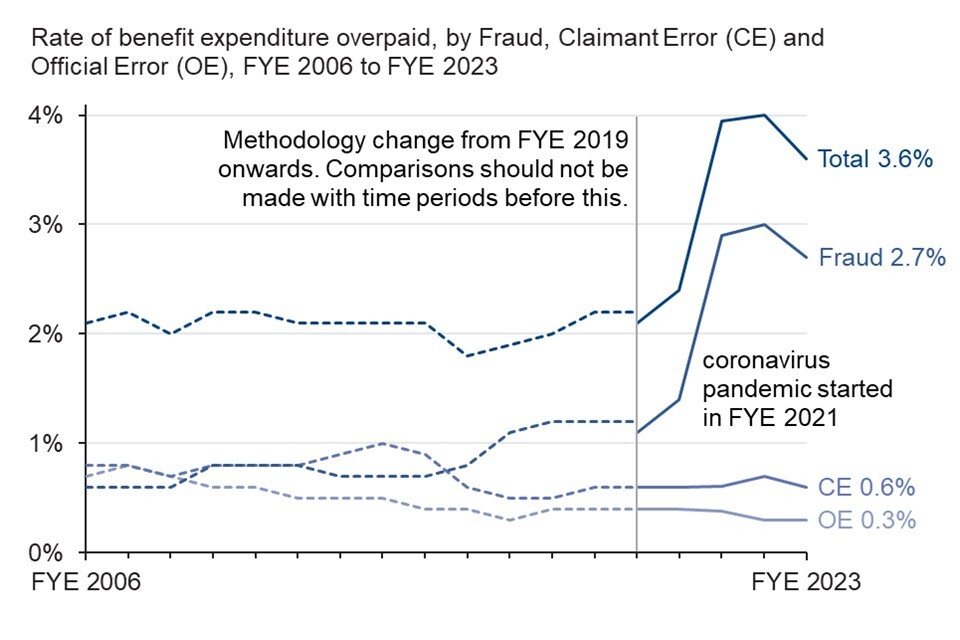
Overpayments due to Fraud were 2.7% (£6.4bn) in FYE 2023, compared with 3.0% (£6.5bn) in FYE 2022 which was the highest recorded level.
Overpayments due to Claimant Error were 0.6% (£1.4bn) in FYE 2023, compared with 0.7% (£1.5bn) in FYE 2022.
Overpayments due to Official Error remained at 0.3% in both FYE 2023 (£0.6bn) and FYE 2022 (£0.7bn).
Cost of Living Payments were included for the first time in FYE 2023. If we exclude this expenditure, to give a better comparison to FYE 2022, then the total overpayment rate would have been 3.5%, compared with 4.0% in FYE 2022.
Underpayments
The total rate of benefit expenditure underpaid in FYE 2023 was 1.4% (£3.3bn), which was the highest recorded level, compared with 1.2% (£2.6bn) in FYE 2022.

Underpayments due to Claimant Error were 0.9% (£2.1bn) in FYE 2023, which was the highest recorded level, compared with 0.7% (£1.6bn) in FYE 2022.
Underpayments due to Official Error remained at 0.5% in both FYE 2023 (£1.2bn) and FYE 2022 (£1.1bn).
Net loss from overpayments
DWP can recover overpayments from people. This means not all of the £8.3bn overpaid is lost. A net loss estimate can be calculated, which deducts recoveries from total overpayments. DWP recovered £1.0bn of overpayments in FYE 2023 (£0.4bn from Housing Benefit and £0.6bn from other DWP benefits). The same amount was recovered in FYE 2022.
Some recoveries made by DWP are not included in the net loss estimate, as they do not relate to expenditure included in the fraud and error reporting (mainly recoveries of tax credits and of benefit advances).
The net rate of loss from overpayments in FYE 2023 was 3.1% (£7.3bn), compared with 3.5% (£7.6bn) in FYE 2022.
5. Universal Credit overpayments and underpayments
Universal Credit (UC) is a payment to help with living costs for people who are in work on a low income, or for those who are out of work. Eligibility for UC depends on individual circumstances and location.
The expenditure on UC increased from £40.4bn in FYE 2022 to £43.4bn in FYE 2023. This means that the monetary values of fraud and error cannot be directly compared between these years.
Advance payments of UC are not part of the benefit payment itself and consequently are not reviewed for fraud and error. See section 3 of the background information document for further information.
Overpayments
The Universal Credit overpayment rate decreased from the highest recorded level of 14.7% (£5,920m) in FYE 2022 to 12.8% (£5,540m) in FYE 2023. This was a statistically significant decrease.
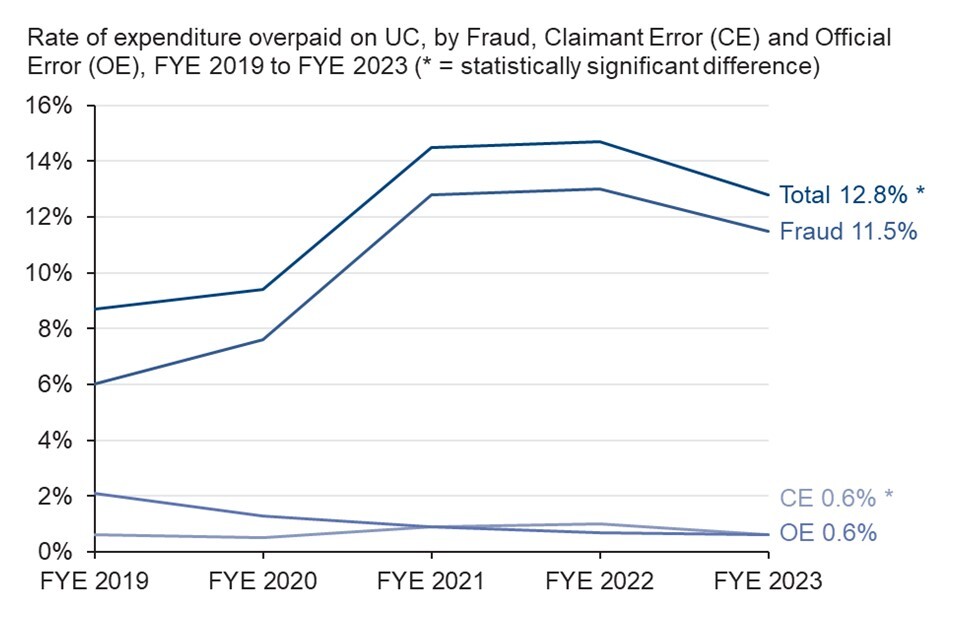
The proportion of claims overpaid remained at 24 in 100 claims in both FYE 2023 and FYE 2022. The decrease in the overpayment rate was primarily due to lower average amounts overpaid in FYE 2023, rather than a lower proportion of claims overpaid.
The coronavirus pandemic continued to have consequences that affected UC fraud and error during FYE 2023. In particular, the Minimum Income Floor (MIF) was temporarily suspended to help UC claimants during the coronavirus pandemic. The MIF is an assumed level of earnings used in the monthly UC payment calculation. It affects self-employed claimants expected to work while receiving UC. The MIF has been reinstated in a phased approach that started in August 2021. It is estimated that the overpayment rate for FYE 2023 could have been 12.4%, rather than 12.8%, if there had been no disruption to the MIF process.
Overpayments due to Fraud were 11.5% (£5,010m) in FYE 2023, compared with 13.0% (£5,250m) in FYE 2022 which was the highest recorded level.
The largest decreases in Fraud overpayments were due to Earnings/Employment and Conditions of Entitlement.
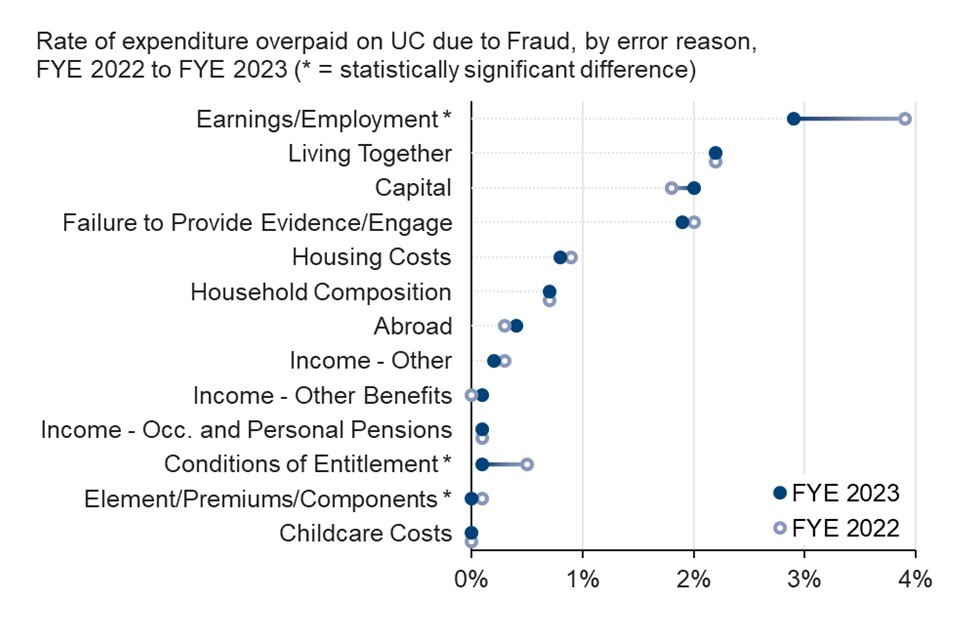
Under-declaration of income from work undertaken (Earnings/Employment) remained the largest source of Fraud, despite decreasing from 3.9% in FYE 2022 to 2.9% in FYE 2023. This reduction was caused by a decrease in Fraud relating to under-declared income from self-employed work (Self Employed Earnings) from 3.6% in FYE 2022 to 2.3% in FYE 2023. Both were statistically significant decreases.
Conditions of Entitlement had the second largest decrease in Fraud, from 0.5% in FYE 2022 to 0.1% in FYE 2023, due to a fall in the proportion of claims failing to meet the UC eligibility criteria. This was a statistically significant decrease.
Single claimants who fail to declare living with a partner (Living Together) remained the second largest source of Fraud, it was unchanged at 2.2% in both FYE 2023 and FYE 2022. Under-declaration of financial assets (Capital) was the third largest source of Fraud, it was 2.0% in FYE 2023 compared with 1.8% in FYE 2022.
Overpayments due to Claimant Error decreased from 1.0% (£400m) in FYE 2022, the highest recorded level, to 0.6% (£280m) in FYE 2023. This was a statistically significant decrease. There was no main driver for the reduction which was a combined effect of small differences across the error reasons.
Overpayments due to Official Error were at the lowest recorded level of 0.6% (£250m) in FYE 2023, compared with 0.7% (£270m) in FYE 2022. This was consistent with a long-term decreasing trend for Official Error overpayments.
Underpayments
The Universal Credit underpayment rate increased to the highest recorded level of 1.6% (£680m) in FYE 2023, having previously been at the joint-lowest recorded level of 1.0% (£410m) in FYE 2022. This was a statistically significant increase.
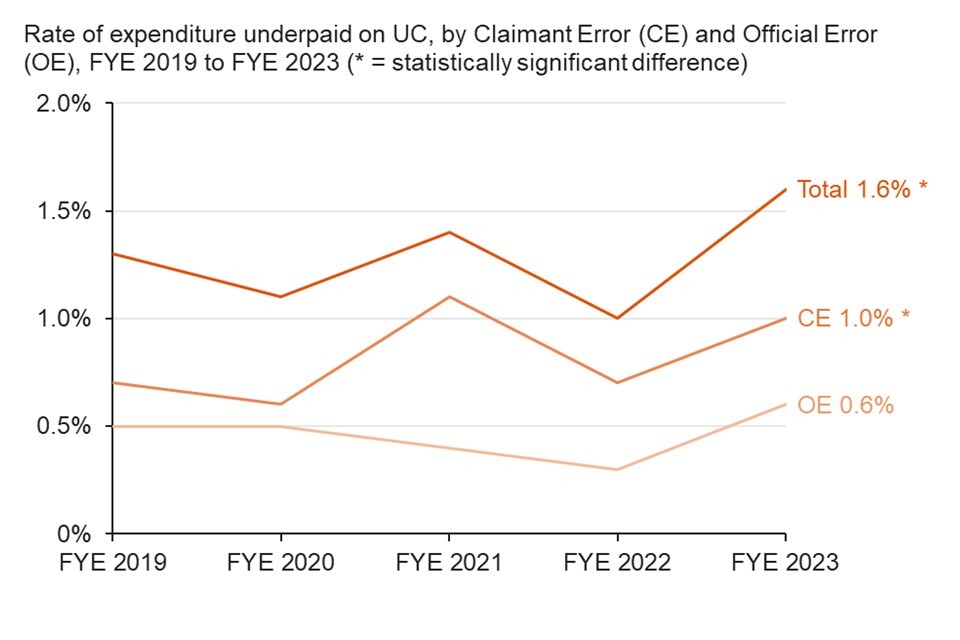
There had previously been a decrease in the underpayment rate between FYE 2021 and FYE 2022. The rate of expenditure underpaid continues to fluctuate year-to-year.
The proportion of claims underpaid remained at 9 in 100 claims in both FYE 2023 and FYE 2022. The increase in the underpayment rate was primarily due to higher average amounts underpaid in FYE 2023, rather than an increase in the proportion of claims underpaid.
Underpayments due to Claimant Error increased from 0.7% (£270m) in FYE 2022 to 1.0% (£430m) in FYE 2023. This was a statistically significant increase which contributed to the change in the total underpayment rate.
Claimant Error underpayments due to failure to declare income from other benefits (Income – Other Benefits) increased from 0.1% in FYE 2022 to 0.2% in FYE 2023. This was a statistically significant increase which related to an increase in the proportion of claims where the disabled child element of UC was underpaid. This was due to the claimant failing to correctly declare the rate of the qualifying benefit which entitled them to the disabled child element.
The award of UC is made up of several different elements. Claimant Error relating to the underpayment of one of these elements (Element/Premium/Components) increased from 0.1% in FYE 2022 to 0.2% in FYE 2023. This was a statistically significant increase and was due to a rise in the proportion of claims being underpaid the carer element of UC.
Failure to provide evidence of rent or under-declared rent and/or service charges (Housing Costs) remained the largest error reason for Claimant Error underpayments, it was 0.4% in FYE 2023 compared with 0.2% in FYE 2022.
Underpayments due to Official Error were 0.6% (£240m) in FYE 2023, compared with 0.3% (£140m) in FYE 2022 which was the lowest recorded level.
6. State Pension overpayments and underpayments
State Pension (SP) is paid to people who have reached the minimum age to claim (66 years old in FYE 2023) and have enough qualifying years on their National Insurance record.
The expenditure on SP increased from £104.5bn in FYE 2022 to £109.7bn in FYE 2023. SP is the benefit with the highest expenditure and accounts for almost one-half of the total benefit expenditure.
Two revisions have been made for SP: a return to using the previous methodology to estimate fraud and error on overseas claims, and a revision to all figures relating to the proportion of claims with fraud or an error. See section 2 of the background information document for further information on these changes. The FYE 2022 estimates have been revised to allow for direct comparisons.
Overpayments
The State Pension overpayment rate remained at 0.1% in both FYE 2023 (£100m) and FYE 2022 (£130m).
Overpayments due to Fraud remained at 0.0% in both FYE 2023 (£0m) and FYE 2022 (£20m).
Overpayments due to Claimant Error remained at 0.1% in both FYE 2023 (£60m) and FYE 2022 (£60m).
Overpayments due to Official Error remained at 0.0% in both FYE 2023 (£40m) and FYE 2022 (£50m).
The proportion of claims overpaid remained at 2 in 100 claims in both FYE 2023 and FYE 2022.
Underpayments
The State Pension underpayment rate was 0.6% (£670m) in FYE 2023, which was the highest recorded level, compared with 0.5% (£540m) in FYE 2022.
Underpayments due to Claimant Error increased from 0.0% (£10m) in FYE 2022 to 0.1% (£90m) in FYE 2023. This was a statistically significant increase.
All Claimant Error underpayments were within the reason of Other. These errors were due to claimants who failed to report a change in their personal circumstances, either through marital separation or bereavement, that would result in an amendment to their award.
Official Error was the main cause of underpayment on State Pension. The Official Error underpayment rate remained at 0.5% in both FYE 2023 (£580m) and FYE 2022 (£530m).
Errors relating to the department failing to take action on changes to marital status or at age related trigger points (Control activities are not carried out appropriately) remained the main source of Official Error underpayments, at 0.3% in both FYE 2023 and FYE 2022. The main types of underpayments within this category in FYE 2023 were:
-
people who are married or in a civil partnership who reached State Pension age before 6 April 2016 and may be automatically entitled, following a 2008 legislative change, to a Category BL State Pension uplift based on their husband, wife or civil partner’s National Insurance contributions
-
people who have been widowed and their State Pension was not uplifted to include amounts they are entitled to inherit from their late husband, wife or civil partner
Errors relating to the incorrect recording of a claimant’s National Insurance contributions (Contributions) remained the second largest source of Official Error underpayments, the rate was 0.1% in FYE 2023, compared with 0.2% in FYE 2022.
The main type of underpayment within this category relates to historic recording of Home Responsibilities Protection (HRP) (administered by HMRC).
For people reaching State Pension age before 6 April 2010, HRP reduced the number of qualifying years needed for a basic State Pension where someone stayed at home to care for children for whom they received Child Benefit or a person who was sick or disabled.
For people reaching SP age on or after 6 April 2010, previously recorded periods of HRP were converted into National Insurance credits. Errors occurred where periods when HRP was due were not accurately recorded on their National Insurance record.
The proportion of claims underpaid remained at 6 in 100 claims in both FYE 2023 and FYE 2022.
Exclusion of errors 10p or less from the proportion of claims in error
Last year we took a de minimis approach to a specific type of error on SP. More information can be found in the State Pension section of the FYE 2022 publication. This year we have applied the de minimis approach to all error types across all benefits. This means that all errors of 10p or less are reported separately to the headline measures of the proportion of claims overpaid or underpaid. This is due to the impact they would have on the estimate of Official Error in relation to the value and level of these errors, and the potential to mislead users of the statistics, including those in receipt of State Pension.
The de minimis approach has the greatest impact on SP. For overpayments these errors affected 9 in 100 claims and for underpayments 21 in 100 claims in FYE 2023.
The majority of these errors were caused by how the Pension Strategy Computer System (PSCS) uprates the Graduated Retirement Benefit component of State Pension. These uprating errors had very small values, with over 99% being equal to 1p or 2p per week (and all errors less than 4p).
7. Personal Independence Payment overpayments and underpayments
Personal Independence Payment (PIP) estimates for FYE 2023 are compared with estimates from FYE 2020 in this publication. PIP was last measured in FYE 2020. It is not possible to infer when any changes occurred within this three-year period. It should be noted that comparisons are made between pre-pandemic (FYE 2020) and post-pandemic (FYE 2023) time periods.
PIP helps with extra costs caused by long-term disability or ill-health. From April 2013, PIP started to replace Disability Living Allowance for people of working age.
The expenditure on PIP increased from £12.5bn in FYE 2020 to £17.7bn in FYE 2023. This means that the monetary values of fraud and error cannot be directly compared between these years.
PIP reviews were carried out by home visit up to and including FYE 2020. Reviews in FYE 2023 were carried out by phone. It has been assumed that the change in review method has not impacted the total estimates of PIP fraud and error. All future reviews will be carried out by phone.
Overpayments
The Personal Independence Payment overpayment rate was at the lowest recorded level of 1.1% (£200m) in FYE 2023, compared with 1.5% (£190m) in FYE 2020.
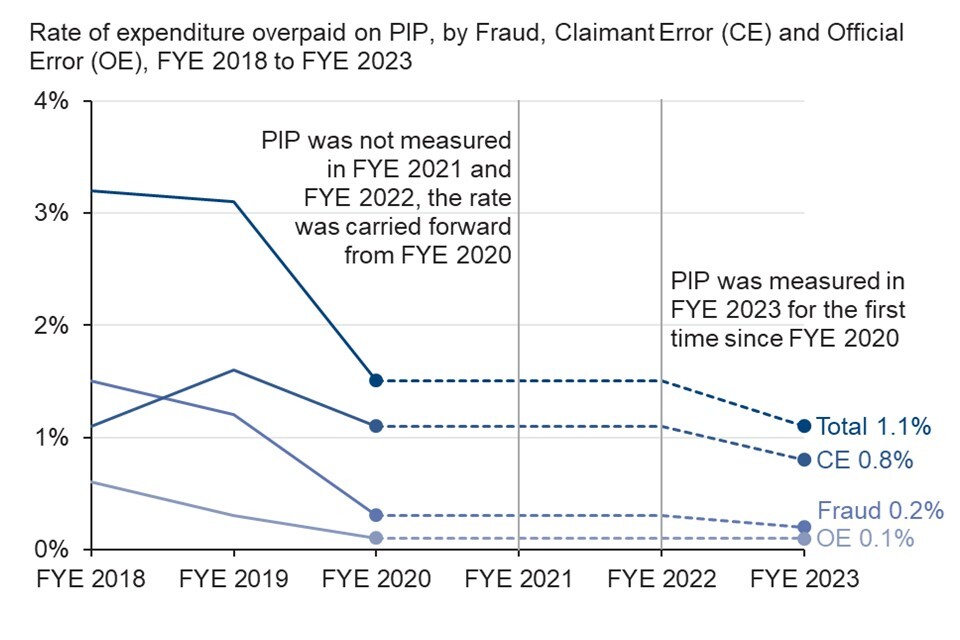
Overpayments due to Fraud were 0.2% (£40m) in FYE 2023, compared with 0.3% (£30m) in FYE 2020.
Overpayments due to Claimant Error were 0.8% (£140m) in FYE 2023, compared with 1.1% (£140m) in FYE 2020.
Overpayments due to Official Error remained at 0.1% in both FYE 2023 (£20m) and FYE 2020 (£20m).
Errors where the claimant’s condition had improved and they failed to inform the department (Functional Needs) accounted for over £8 in every £10 overpaid on PIP in FYE 2023, with an overpayment rate of 0.9%. This was the lowest estimated rate since FYE 2018 and was the reason for the lowest recorded level of overpayments in FYE 2023.
Claims excluded from the overpayment estimates, due to a categorisation of Not Reasonably Expected to Know (Not RETK), have decreased from 3.4% in FYE 2020 to 1.4% in FYE 2023. This was a statistically significant decrease. This is where the claimant was incorrectly overpaid, but the department would not reasonably expect them to know to report the change. Not RETK claims are all classified as Claimant Error due to Functional Needs. The background information document provides further information.
The proportion of claims overpaid was 1 in 100 claims in FYE 2023, compared with 2 in 100 claims in FYE 2020.
Underpayments
The Personal Independence Payment underpayment rate increased from 3.8% (£470m) in FYE 2020 to 5.1% (£900m) in FYE 2023. This was because underpayments due to Claimant Error increased from 3.1% (£390m) in FYE 2020 to 4.8% (£840m) in FYE 2023. Both were statistically significant increases to the highest recorded levels in FYE 2023.
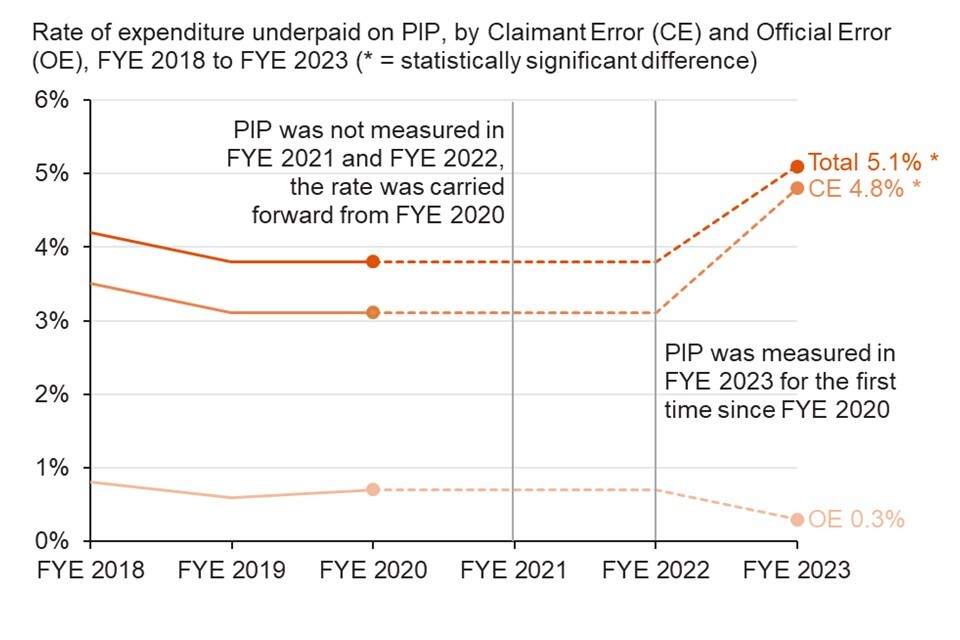
PIP was not measured in either FYE 2021 or FYE 2022. There have been changes between the measured estimates in FYE 2020 and FYE 2023. However, it is not possible to determine if, or when, statistically significant differences may have occurred during the unmeasured time period.
All Claimant Error underpayments were due to errors where the claimant’s condition had got worse and they failed to inform the department (Functional Needs), which accounted for over £9 in every £10 underpaid on PIP in FYE 2023. The increase for this error reason led to the increases in both total Claimant Error and total underpayments in FYE 2023.
The rise in underpayments was due to an increase in Functional Needs from 3.1% in FYE 2020 to 4.8% in FYE 2023. This was a statistically significant increase.
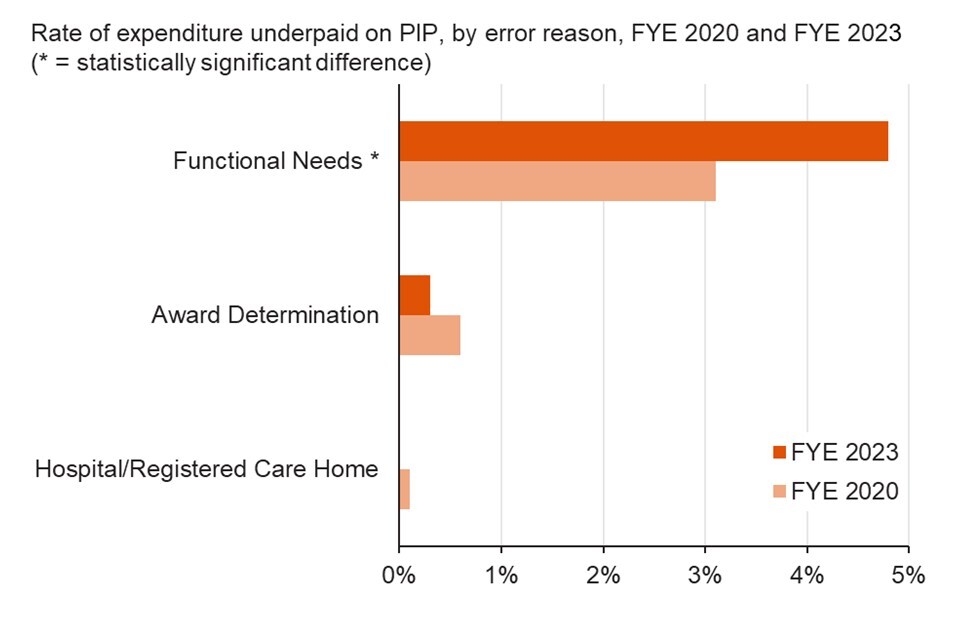
Underpayments due to Official Error were 0.3% in FYE 2023 (£60m), compared with 0.7% in FYE 2020 (£80m).
The proportion of claims underpaid increased from 9 in 100 in FYE 2020 to 13 in 100 claims in FYE 2023. This was a statistically significant increase which led to the increase in the total PIP underpayment rate.
8. Housing Benefit overpayments and underpayments
Housing Benefit (HB) can help pay rent for people who are unemployed, on a low income, or claiming benefits. How much they get depends on their income and circumstances. For working age people, HB is being replaced by Universal Credit (UC), so this group will gradually move onto UC. Working age people cannot make new claims for HB unless they are in supported, sheltered, or temporary housing. Pension age people can continue to make new claims for HB.
The expenditure on HB decreased from £16.5bn in FYE 2022 to £15.0bn in FYE 2023. This is partially due to working age claimants moving onto UC.
These estimates relate to all of Housing Benefit, but estimates are also published separately for working age and pension age claimants (see reference tables). These two groups are made up of “passported” claims (who get HB because they receive another qualifying income-related benefit) and “non-passported” claims (who get HB without one of these qualifying benefits). This means that HB is made up of four groups: passported working age, non-passported working age, passported pension age, and non-passported pension age. The four groups are combined for the total HB estimates.
Only non-passported working age claims were reviewed in FYE 2023. The estimates for the other groups relate to reviews undertaken in previous years; the rates of fraud and error found when each group was last measured have been applied to the FYE 2023 expenditure.
Last year, an adjustment was made to the HB expenditure data that is used to produce the estimates. The methodology used to make this adjustment has been refined and the impact is minimal. The FYE 2022 estimates have been revised using this methodology to allow for direct comparisons. For more information see the background information document.
Overpayments
The Housing Benefit overpayment rate was 5.5% (£820m) in FYE 2023, compared with 5.3% (£880m) in FYE 2022.

Overpayments due to Fraud were 3.5% (£520m) in FYE 2023, compared with 3.3% (£550m) in FYE 2022.
Under-declaration of income or failure to declare an increase in income from work undertaken (Earnings/Employment) remained the largest source of Fraud at 1.0% in FYE 2023, compared with 0.8% in FYE 2022. Earnings/Employment errors can be due to employee or self-employed earnings. Most Earnings/Employment Fraud related to work done for an employer (Employee Earnings), which was 0.8% in FYE 2023, compared with 0.7% in FYE 2022.
Under-declaration of financial assets (Capital) remained the second largest source of Fraud overpayments, it was 0.7% in FYE 2023, compared with 0.6% in FYE 2022.
Overpayments due to Claimant Error remained at 1.6% in both FYE 2023 (£240m) and FYE 2022 (£260m).
Overpayments due to Official Error remained at 0.4% in both FYE 2023 (£60m) and FYE 2022 (£70m).
The proportion of claims overpaid remained at 15 in 100 claims in both FYE 2023 and FYE 2022.
Underpayments
The HB underpayment rate was at the lowest recorded level of 1.1% (£170m) in FYE 2023, compared with 1.3% (£220m) in FYE 2022.
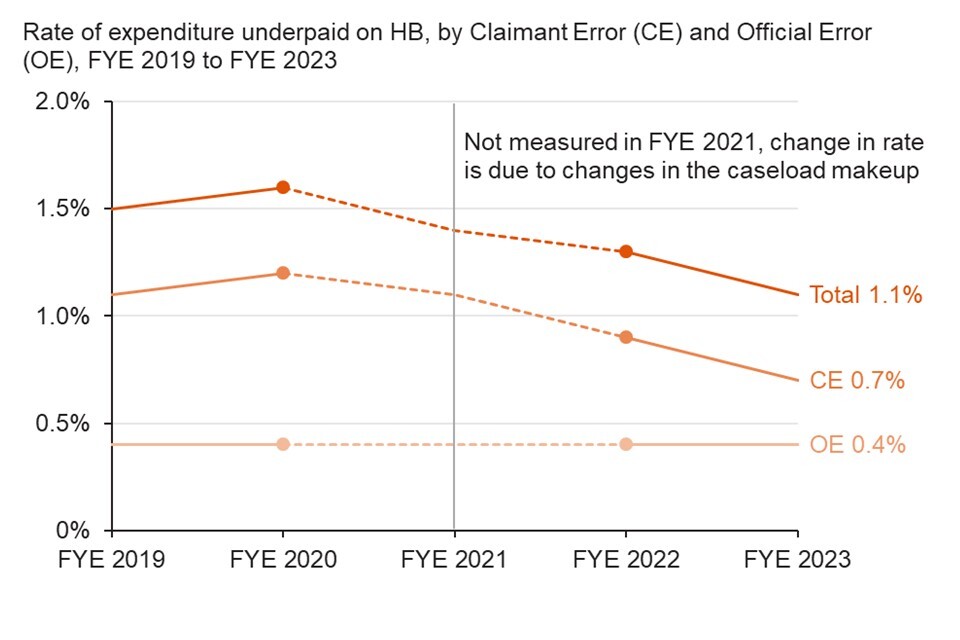
Underpayments due to Claimant Error were 0.7% (£110m) in FYE 2023, compared with 0.9% (£140m) in FYE 2022.
Claimant Error underpayments due to overstatement of income or failure to declare a decrease in income from work undertaken (Earnings/Employment) decreased from 0.4% in FYE 2022 to 0.2% in FYE 2023. This reduction was due to a decrease in Employee Earnings Claimant Error, from 0.3% in FYE 2022 to 0.2% in FYE 2023. Both were statistically significant decreases. These changes led to statistically significant decreases in total HB underpayments for Employee Earnings and Earnings/Employment.
Underpayments due to Official Error remained at 0.4% in both FYE 2023 (£60m) and FYE 2022 (£70m).
The proportion of claims underpaid was 8 in 100 claims in FYE 2023, compared with 9 in 100 claims in FYE 2022.
9. Employment and Support Allowance overpayments and underpayments
Employment and Support Allowance (ESA) is paid to people who have limited capability to work due to disability or illness.
Income-related ESA is being replaced with Universal Credit (UC).
New Style ESA is a contributory benefit and is not part of the migration to UC. It is possible to receive New Style ESA and UC at the same time. Since February 2021 new claims for ESA are only possible for New Style ESA.
The expenditure on ESA decreased from £12.6bn in FYE 2022 to £12.1bn in FYE 2023. This is partially due to some claimants moving onto UC.
Overpayments
The Employment and Support Allowance overpayment rate was 3.4% (£410m) in FYE 2023, compared with 4.0% (£500m) in FYE 2022.
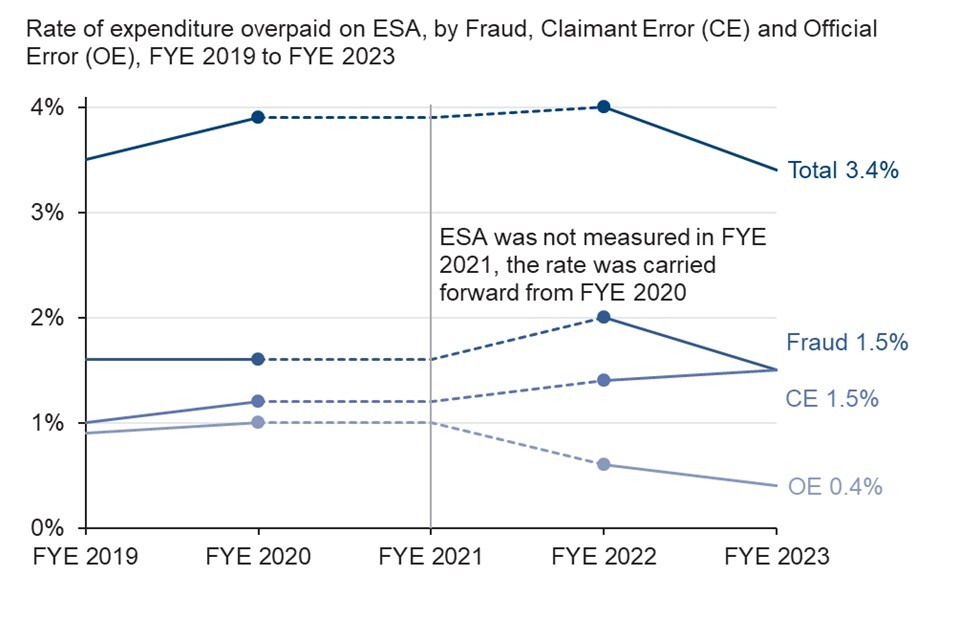
Under-declaration of financial assets (Capital) remained the largest source of total overpayments, it was 1.4% in FYE 2023 compared with 1.3% in FYE 2022. This is twice the rate of the second largest error reason, under-declaration of income or failure to declare an increase in income from work undertaken (Earnings/Employment), which was 0.7% in FYE 2023.
Overpayments due to Fraud were 1.5% (£180m) in FYE 2023, compared with 2.0% (£250m) in FYE 2022.
Overpayments due to Claimant Error were at the highest recorded level of 1.5% (£190m) in FYE 2023, compared with 1.4% (£180m) in FYE 2022.
Claimant Error overpayments due to Capital increased from 0.5% in FYE 2022 to 0.9% in FYE 2023. This was a statistically significant increase.
Overpayments due to Official Error were at the lowest recorded level of 0.4% (£40m) in FYE 2023, compared with 0.6% (£80m) in FYE 2022.
Additional amounts of ESA can be paid if a claimant meets certain conditions, these are called premiums. Official Error where the department has incorrectly overpaid any of these premiums (Element/Premium/Components) decreased from 0.3% in FYE 2022 to 0.1% in FYE 2023. This was a statistically significant decrease and was due to a reduction in the proportion of claims being overpaid the severe disability premium. Since this error reason only applies to Official Error, the same statistically significant decrease was observed for total ESA overpayments.
The proportion of claims overpaid was 10 in 100 claims in FYE 2023, compared with 12 in 100 claims in FYE 2022.
Underpayments
The Employment and Support Allowance underpayment rate was 2.4% (£290m) in FYE 2023, compared with 2.5% (£320m) in FYE 2022.
The three largest error reasons for underpayments in FYE 2023 were:
-
underpayments relating to premiums (Element/Premium/Components), which remained at 0.8% in both FYE 2023 and FYE 2022
-
errors arising where the claimant failed to notify the department that they live alone (Household Composition), which was 0.8% in FYE 2023 compared with 0.7% in FYE 2022
-
underpayments due to failure to declare income from other benefits (Income – Other Benefits), which was 0.5% in FYE 2023, compared with 0.8% in FYE 2022 – when it was the joint-largest error reason, alongside Household Composition
Element/Premium/Components, Household Composition, and Income – Other Benefits accounted for around £9 in every £10 underpaid on ESA. Errors in these categories predominantly related to claimants not receiving severe disability premium to which they were entitled.
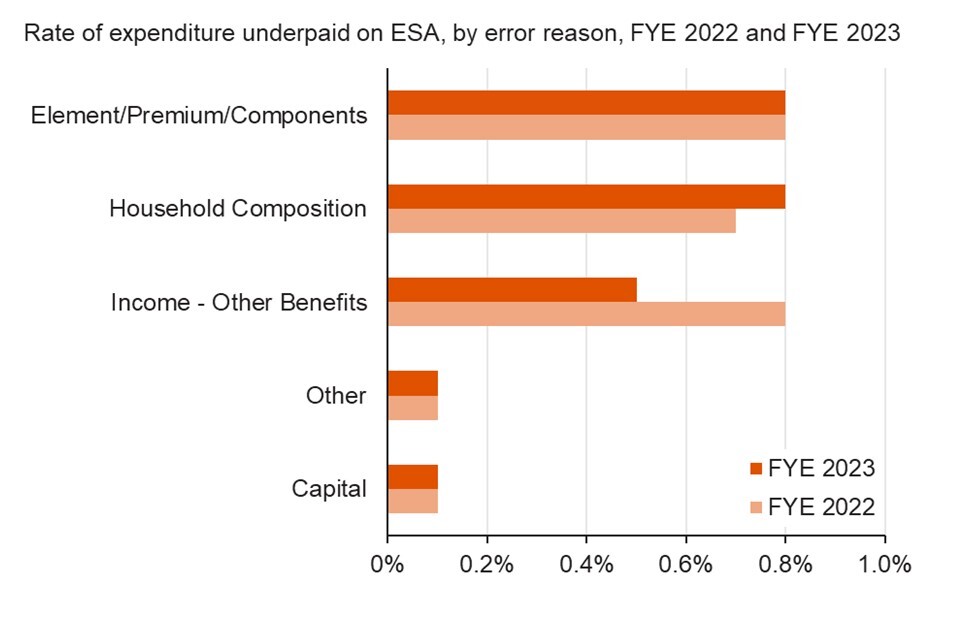
Underpayments due to Claimant Error were 1.3% (£160m) in FYE 2023, compared with 1.4% (£180m) in FYE 2022.
Claimant Error underpayments due to over-declaration of financial assets (Capital) increased from 0.0% in FYE 2022 to 0.1% in FYE 2023. This was a statistically significant increase.
Underpayments due to Official Error remained at 1.1% in both FYE 2023 (£130m) and FYE 2022 (£130m).
The proportion of claims underpaid was 7 in 100 claims in FYE 2023, compared with 6 in 100 claims in FYE 2022.
10. Pension Credit overpayments and underpayments
Pension Credit (PC) provides support to people who have reached State Pension age. Guarantee Credit tops up any other income to a ‘standard minimum guarantee’ amount and additional amounts may be payable in certain circumstances, for example, severe disability. Savings Credit is an extra payment for those who have made some additional provision for their retirement through, for example, an occupational pension or savings. Those reaching State Pension age from 6 April 2016 are not eligible for Savings Credit.
The expenditure on PC increased from £4.8bn in FYE 2022 to £4.9bn in FYE 2023.
Overpayments
The Pension Credit overpayment rate was 6.7% (£330m) in FYE 2023, compared with the highest recorded level of 7.3% (£350m) in FYE 2022.
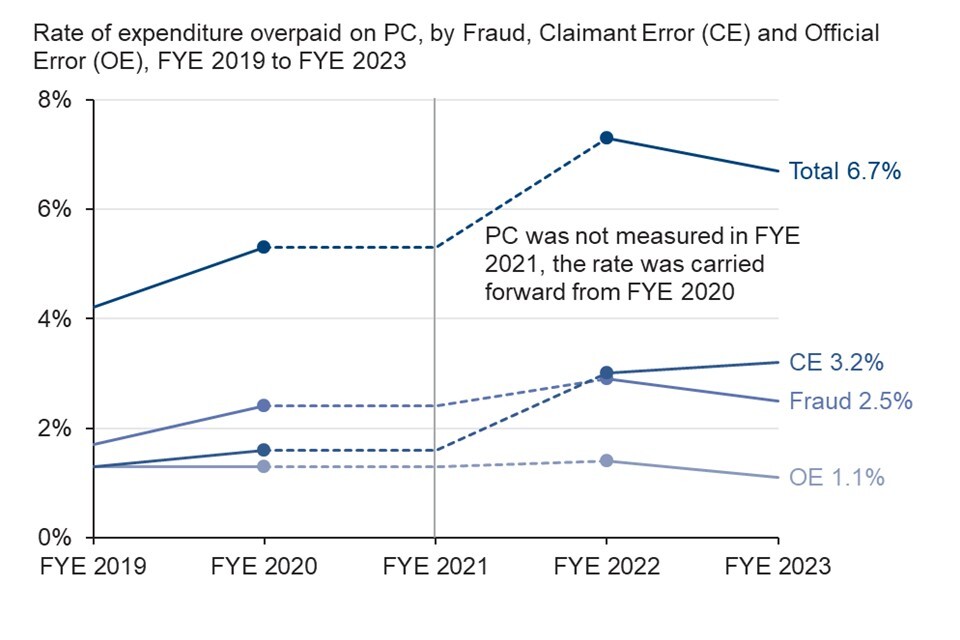
Under-declaration of financial assets (Capital) remained the largest source of overpayments, it was 2.8% in FYE 2023 compared with 2.3% in FYE 2022. Capital accounted for over £4 in every £10 overpaid on PC in FYE 2023.
Overpayments due to Fraud were 2.5% (£120m) in FYE 2023, compared with 2.9% (£140m) in FYE 2022.
Claimants remaining abroad for a longer period than is allowed (Abroad) remained the largest source of Fraud, it was 1.1% in FYE 2023 compared with 1.7% in FYE 2022.
Overpayments due to Claimant Error were 3.2% (£150m) in FYE 2023, compared with 3.0% (£150m) in FYE 2022, which was the previous highest recorded level.
Overpayments due to Official Error were 1.1% (£50m) in FYE 2023, compared with 1.4% (£70m) in FYE 2022, the lowest recorded level to date.
Overpayments due to Income – Occupational and Personal Pensions decreased because of:
-
Claimant Error due to under-declared non-state pensions or failure to declare non-state pensions, which decreased from 0.6% in FYE 2022 to 0.3% in FYE 2023
-
Official Error where the department has accounted for a smaller amount of non-state pension than it should have, which decreased from 0.2% in FYE 2022 to 0.0% in FYE 2023
Both were statistically significant decreases.
The proportion of claims overpaid was 23 in 100 claims in FYE 2023, compared with 24 in 100 claims in FYE 2022.
Underpayments
The Pension Credit underpayment rate was 2.0% (£100m) in FYE 2023, compared with 2.1% (£100m) in FYE 2022. This was the lowest recorded level since FYE 2015.
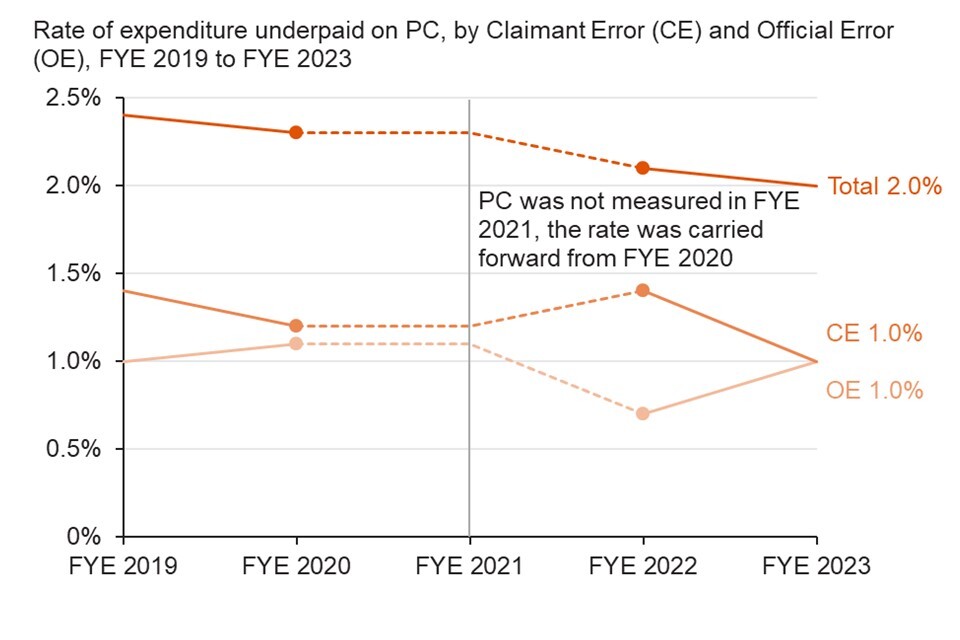
Underpayments due to Claimant Error were 1.0% (£50m) in FYE 2023, compared with 1.4% (£70m) in FYE 2022.
Additional amounts of PC can be paid if a claimant meets certain conditions, they are often called premiums. Errors arising where the claimant has failed to notify the department that they live alone, and which would give entitlement to a premium (Household Composition) remained the largest source of Claimant Error underpayments. The rate remained at 0.5% in both FYE 2023 and FYE 2022 and accounted for almost £5 in every £10 underpaid on PC due to Claimant Error in FYE 2023.
Underpayments due to Official Error were 1.0% (£50m) in FYE 2023, compared with 0.7% (£30m) in FYE 2022.
Official Error where the department has incorrectly underpaid any premiums (Element/Premium/Components) remained the largest source of Official Error underpayments. The rate was 0.6% in FYE 2023, compared with 0.5% in FYE 2022, and accounted for almost £6 in every £10 underpaid on PC due to Official Error in FYE 2023. These errors mostly related to an unpaid extra addition for severe disability premium.
The proportion of claims underpaid remained at 7 in 100 claims in both FYE 2023 and FYE 2022.
11. Cost of Living Payments overpayments and underpayments
The department made extra payments to recipients of certain benefits, called Cost of Living Payments, for the first time in FYE 2023. These payments were made to help claimants with the increased cost of living. The Cost of Living Payments fraud and error amounts and rates that appear in this publication are only associated with those where the payment was made by DWP. Cost of Living Payments were also made to Tax Credit and War Pension Mobility Supplement claimants but these are excluded from our estimates. The following table lists the benefits that qualified claimants for Cost of Living Payments paid by DWP.
| Benefit Type | Benefit |
|---|---|
| Low-income | Universal Credit |
| Low-income | Pension Credit |
| Low-income | Income-Related Employment and Support Allowance |
| Low-income | Income-Based Jobseeker’s Allowance |
| Low-income | Income Support |
| Disability | Attendance Allowance |
| Disability | Constant Attendance Allowance |
| Disability | Disability Living Allowance |
| Disability | Personal Independence Payment |
| Disability | Armed Forces Independence Payment |
| Pensioner | Winter Fuel Payments |
The expenditure on Cost of Living Payments was £8.4bn in FYE 2023.
Fraud and error on Cost of Living Payments was not directly measured in FYE 2023. Estimates were produced by assuming that fraud and error could only occur when claimants were incorrectly receiving the qualifying benefit. In this situation, the claimant does not have entitlement to the qualifying benefit, and they are overpaid the full amount of the Cost of Living Payments. This methodology means that no underpayments were estimated on Cost of Living Payments for FYE 2023.
Most of the qualifying benefits have been measured for fraud and error in FYE 2023, or in recent years. The rate at which claimants were found not to have entitlement to each qualifying benefit, at the most recent measurement, was applied to the Cost of Living Payments’ expenditure relating to that benefit. The amount of Cost of Living Payments overpaid from each qualifying benefit was then summed to give monetary estimates. These were divided by the Cost of Living Payments expenditure to give the overpayment rate estimates.
The background information document provides more information on Cost of Living Payments, how the estimates were calculated and omissions relating to the estimates.
The Cost of Living Payments overpayment rate was 4.9% (£410m) in FYE 2023.
Overpayments due to Fraud were 3.7% (£310m) in FYE 2023.
Overpayments due to Claimant Error and Official Error were estimated at 0.8% (£60m) and 0.5% (£40m) respectively.
Overpayments relating to incorrectly paid low-income benefits accounted for around £9 in every £10 overpaid on Cost of Living Payments, at 4.6% (£380m) in FYE 2023. This was mostly due to 3.9% (£330m) of Cost of Living Payments expenditure being overpaid to claimants incorrectly receiving Universal Credit.
The fraud and error estimates for Cost of Living Payments are included within the FYE 2023 “Unreviewed” line in reference tables 1, 2, 7 and 8.
12. About these statistics
All the information underlying the charts and figures featured in this publication is included in the accompanying reference tables.
The tables show the rates and monetary values of overpayments and underpayments for each benefit, split by Fraud, Claimant Error and Official Error. The tables also show the net loss of overpayments measure, with a time series and a breakdown by benefit.
More detail about the cause of the error (for example: income, savings and who lives in the household), and the demographics of the claimants, is provided for benefits measured this year. The proportion of claims that are overpaid or underpaid and the amount of money that is incorrectly paid are also estimated.
The background information document provides further information on how the ‘Fraud and error in the benefit system’ statistics are calculated and gives a glossary of the causes of fraud and error used in this publication and the reference tables. It also contains further details on any methodological changes which have been introduced.
We continuously review the content of this publication to ensure that our statistics are as accurate and relevant as possible. As Universal Credit (UC) continues to replace existing benefits, and the managed migration of claims progresses, we want to ensure that our longstanding measurement methodologies of Fraud, Claimant Error and Official Error align with UC legislation. We will therefore be carrying out a review of these methodologies to ensure they align with UC legislation.
The Fraud and error in the benefit system: publication strategy provides further information on upcoming plans for future releases of these statistics.
User comments are welcomed and should be sent to: caxtonhouse.femaenquiries@dwp.gov.uk.
National Statistics status
National Statistics status means that these statistics meet the highest standards of trustworthiness, quality and public value, and there is a responsibility to maintain compliance with these standards.
The continued designation of these statistics as National Statistics was confirmed in December 2017, following a compliance check by the Office for Statistics Regulation (OSR). The statistics last underwent a full assessment against the Code of Practice for Statistics in February 2012. Since the latest review by OSR, these statistics have been maintained in compliance with the Code of Practice for Statistics, whilst the following improvements have been made:
-
a user consultation was conducted on the frequency of the publication, the benefits measured, and on the breakdowns used within the publication. This resulted in a change from a bi-annual to an annual publication cycle and beginning to measure fraud and error on benefits that have not been measured at all or for a long time
-
methodological changes have been implemented, resulting in better understood methodologies and assumptions, improved accuracy of the fraud and error statistics, and improved consistency across benefits
-
changes have been made to improve the relevance and accessibility of the statistics. For example: shifting away from standard wording and charts to bespoke commentary for each measured benefit; updating the categories of error reported in the publication, based on user needs; making the published data available to analysts within DWP; producing the publication in HTML format and providing an accessible version of the reference tables
Other National and Official Statistics
Read about other National and Official Statistics produced by DWP.
13. Contact information
Lead Statistician: Michael Holland
Feedback or enquiries about these statistics should be directed by email to: caxtonhouse.femaenquiries@dwp.gov.uk
DWP Press Office: 0115 965 8781
Report Benefit Fraud: 0800 854 4400
Appendix 1: FYE 2023 overpayment rates and monetary values by benefit
| Expenditure (£m) | Total Rate (%) | Total Value (£m) | Fraud Rate (%) | Fraud Value (£m) | Claimant Error Rate (%) | Claimant Error Value (£m) | Official Error Rate (%) | Official Error Value (£m) | Last measured | |||||||||||
|---|---|---|---|---|---|---|---|---|---|---|---|---|---|---|---|---|---|---|---|---|
| Universal Credit | 43,400 | 12.8 | 5,540 | 11.5 | 5,010 | 0.6 | 280 | 0.6 | 250 | Nov 2021 to Oct 2022 | ||||||||||
| State Pension | 109,700 | 0.1 | 100 | 0.0 | 0 | 0.1 | 60 | 0.0 | 40 | Sep 2021 to Sep 2022 | ||||||||||
| Personal Independence Payment | 17,700 | 1.1 | 200 | 0.2 | 40 | 0.8 | 140 | 0.1 | 20 | Nov 2021 to Jul 2022 | ||||||||||
| Housing Benefit | 15,000 | 5.5 | 820 | 3.5 | 520 | 1.6 | 240 | 0.4 | 60 | Nov 2021 to Sep 2022 | ||||||||||
| Employment and Support Allowance | 12,100 | 3.4 | 410 | 1.5 | 180 | 1.5 | 190 | 0.4 | 40 | Sep 2021 to Aug 2022 | ||||||||||
| Disability Living Allowance | 6,000 | 1.9 | 110 | 0.5 | 30 | 0.6 | 40 | 0.8 | 50 | Apr 2004 to Mar 2005 | ||||||||||
| Attendance Allowance | 5,700 | 2.2 | 130 | 0.0 | 0 | 1.9 | 110 | 0.3 | 20 | Oct 2020 to Aug 2021 | ||||||||||
| Pension Credit | 4,900 | 6.7 | 330 | 2.5 | 120 | 3.2 | 150 | 1.1 | 50 | Sep 2021 to Sep 2022 | ||||||||||
| Carer’s Allowance | 3,300 | 5.2 | 170 | 3.0 | 100 | 2.0 | 70 | 0.1 | 0 | May 2019 to Dec 2019 | ||||||||||
| Income Support | 600 | 3.9 | 20 | 2.4 | 20 | 1.0 | 10 | 0.4 | 0 | Oct 2013 to Sep 2014 | ||||||||||
| Jobseeker’s Allowance | 300 | 4.6 | 10 | 3.1 | 10 | 0.3 | 0 | 1.2 | 0 | Oct 2017 to Sep 2018 | ||||||||||
| Incapacity Benefit | 0 | 2.4 | 0 | 0.3 | 0 | 0.9 | 0 | 1.2 | 0 | Oct 2009 to Sep 2010 | ||||||||||
| Interdependencies | 50 | 10 | 20 | 20 | ||||||||||||||||
| Never reviewed | 15,000 | 3.0 | 460 | 2.2 | 320 | 0.5 | 70 | 0.4 | 60 | |||||||||||
| Total | 233,800 | 3.6 | 8,300 | 2.7 | 6,400 | 0.6 | 1,400 | 0.3 | 600 | |||||||||||
| Range | (3.3 to 3.9) | (7,700 to 9,000) | (2.5 to 3.0) | (5,800 to 7,000) | (0.5 to 0.7) | (1,200 to 1,600) | (0.2 to 0.4) | (500 to 800) |
Notes to Appendix 1
- Rows and columns may not sum to totals due to rounding.
- Approximate 95% confidence interval ranges are given for the totals in the row below them. These also allow for non-sample error in occasionally reviewed benefits and the additional uncertainty that comes from the use of older measurement periods.
- A number of claims are removed from the headline overpayment estimates due to a review not being completed and categorised as ‘Inconclusive’. In Financial Year Ending (FYE) 2023, these claims are estimated to have a total monetary value of £960m (Universal Credit £480m, State Pension £210m, Housing Benefit £70m, Carer’s Allowance £40m, Personal Independence Payment £20m, Employment and Support Allowance £70m, Pension Credit £30m and Attendance Allowance £40m). For Attendance Allowance and Carer’s Allowance, the percentages of inconclusive claims found in FYE 2022 and FYE 2020 respectively have been carried forward and applied to the FYE 2022 expenditure for each benefit. See Appendix 3 of the statistical release for more information.
- Certain claims are removed from the headline overpayment estimates for Disability Living Allowance (DLA), Personal Independence Payment (PIP) and Attendance Allowance (AA). Based on Financial Year Ending (FYE) 2023 expenditure, the DLA figure is now estimated to be £430m (£320m, £560m) and the excluded AA figure is estimated to be £40m (£10m, £70m). The excluded PIP figure is estimated to be £240m (£160m, £340m) for FYE 2023. The numbers in brackets are 95% confidence intervals. See the “Benefit-specific adjustments” in section 5 of the background information document for more information.
- Monetary values associated with Incapacity Benefit are displayed as zeros due to rounding.
- Interdependencies is the knock-on effect of Disability Living Allowance (DLA) fraud and error on other benefits, where receipt of DLA or Personal Independence Payment is a qualifying condition. It is only included for overpayments.
- The ‘Never reviewed’ category includes benefits which were not previously reviewed and have not been historically reviewed in a particular year. This includes Cost of Living Payments for the first time this year.
Appendix 2: FYE 2023 underpayment rates and monetary values by benefit
| Expenditure (£m) | Total Rate (%) | Total Value (£m) | Fraud Rate (%) | Fraud Value (£m) | Claimant Error Rate (%) | Claimant Error Value (£m) | Official Error Rate (%) | Official Error Value (£m) | Last measured | |||||||||||
|---|---|---|---|---|---|---|---|---|---|---|---|---|---|---|---|---|---|---|---|---|
| Universal Credit | 43,400 | 1.6 | 680 | 0.0 | 0 | 1.0 | 430 | 0.6 | 240 | Nov 2021 to Oct 2022 | ||||||||||
| State Pension | 109,700 | 0.6 | 670 | 0.0 | 0 | 0.1 | 90 | 0.5 | 580 | Sep 2021 to Sep 2022 | ||||||||||
| Personal Independence Payment | 17,700 | 5.1 | 900 | 0.0 | 0 | 4.8 | 840 | 0.3 | 60 | Nov 2021 to Jul 2022 | ||||||||||
| Housing Benefit | 15,000 | 1.1 | 170 | 0.0 | 0 | 0.7 | 110 | 0.4 | 60 | Nov 2021 to Sep 2022 | ||||||||||
| Employment and Support Allowance | 12,100 | 2.4 | 290 | 0.0 | 0 | 1.3 | 160 | 1.1 | 130 | Sep 2021 to Aug 2022 | ||||||||||
| Disability Living Allowance | 6,000 | 2.5 | 150 | 0.0 | 0 | 2.4 | 140 | 0.1 | 10 | Apr 2004 to Mar 2005 | ||||||||||
| Attendance Allowance | 5,700 | 4.3 | 250 | 0.0 | 0 | 4.2 | 240 | 0.1 | 10 | Oct 2020 to Aug 2021 | ||||||||||
| Pension Credit | 4,900 | 2.0 | 100 | 0.0 | 0 | 1.0 | 50 | 1.0 | 50 | Sep 2021 to Sep 2022 | ||||||||||
| Carer’s Allowance | 3,300 | 0.0 | 0 | 0.0 | 0 | 0.0 | 0 | 0.0 | 0 | May 2019 to Dec 2019 | ||||||||||
| Income Support | 600 | 0.8 | 10 | 0.1 | 0 | 0.4 | 0 | 0.3 | 0 | Oct 2013 to Sep 2014 | ||||||||||
| Jobseeker’s Allowance | 300 | 1.5 | 0 | 0.1 | 0 | 0.3 | 0 | 1.2 | 0 | Oct 2017 to Sep 2018 | ||||||||||
| Incapacity Benefit | 0 | 0.7 | 0 | 0.0 | 0 | 0.0 | 0 | 0.7 | 0 | Oct 2009 to Sep 2010 | ||||||||||
| Never reviewed | 15,000 | 0.4 | 60 | 0.0 | 0 | 0.2 | 30 | 0.2 | 30 | |||||||||||
| Total | 233,800 | 1.4 | 3,300 | 0.0 | 0 | 0.9 | 2100 | 0.5 | 1,200 | |||||||||||
| Range | (1.3 to 1.6) | (2,900 to 3,700) | (0.0 to 0.0) | (0.0 to 0.0) | (0.8 to 1.0) | (1,900 to 2,400) | (0.4 to 0.6) | (900 to 1,500) |
Notes to Appendix 2
- Rows and columns may not sum to totals due to rounding.
- Approximate 95% confidence interval ranges are given for the totals in the row below them. These also allow for non-sample error in occasionally reviewed benefits and the additional uncertainty that comes from the use of older measurement periods.
- Monetary values associated with Incapacity Benefit are displayed as zeros due to rounding.
- The ‘Never Reviewed’ category includes benefits which were not previously reviewed and have not been historically reviewed in a particular year. This includes Cost of Living Payments for the first time this year.
Appendix 3: Cannot Review adjustment
Please see section 5 of the background information document for more information on this adjustment.
The primary reason for an ineffective review is the claimant not engaging in a review, resulting in their benefit claim being suspended and then later terminated. This includes instances where the claimant withdrew their claim to the benefit after they received a review notification.
These ineffective reviews are referred to as ‘Cannot Review’ and, for most claimants, the department holds very little evidence of their current circumstances and their reasons for failing to engage.
For those claims where there is a lack of evidence available, a set of assumptions are applied to categorise them for reporting purposes as follows:
-
Fraud – where a claim has a suspicion of Fraud raised during the initial data gathering prior to review. These claims are assumed to be Fraud in the reported estimates
-
Not Fraud – where there is no information to suggest a suspicion of Fraud and the claimant reclaims the benefit at a similar rate within four months of their original award being terminated. These claims are assumed not to be Fraud. Any other errors such as Official Error would remain on the claim, so they may still not be entirely correct
-
Inconclusive – where there is no information to suggest a suspicion of Fraud or that the claimant has reclaimed the benefit. These claims are recorded as inconclusive, and no assumptions are made. These claims are taken out of the headline reported estimates, since there is insufficient evidence to categorise as Fraud or not. The expenditure for these claims is estimated and reported separately within the publication and reference tables
Cannot Review claims, where there was no evidence of the claimant’s reason for failing to engage, accounted for around £1,250m (0.6% of all expenditure on benefits that have been reviewed since FYE 2020).
FYE 2023 estimates of the breakdown of claims that did not have an effective review, and where there was no evidence of the claimant’s reason for failing to engage, by benefit and assumption categorisation
| Fraud Rate (%) | Fraud Value (£m) | Not Fraud Rate (%) | Not Fraud Value (£m) | Inconclusive Rate (%) | Inconclusive Value (£m) | |||||||
|---|---|---|---|---|---|---|---|---|---|---|---|---|
| Attendance Allowance | 0.0 | 0 | 0.1 | 10 | 0.8 | 40 | ||||||
| Carer’s Allowance | 0.7 | 20 | 0.7 | 20 | 1.2 | 40 | ||||||
| Employment and Support Allowance | 0.0 | 0 | 0.0 | 0 | 0.6 | 70 | ||||||
| Housing Benefit | 0.5 | 70 | 0.3 | 50 | 0.4 | 70 | ||||||
| Pension Credit | 0.2 | 10 | 0.0 | 0 | 0.7 | 30 | ||||||
| Personal Independence Payment | 0.1 | 10 | 0.0 | 0 | 0.1 | 20 | ||||||
| State Pension | 0.0 | 0 | 0.0 | 0 | 0.2 | 210 | ||||||
| Universal Credit | 0.1 | 60 | 0.1 | 40 | 1.1 | 480 | ||||||
| Total | 0.1 | 170 | 0.1 | 110 | 0.5 | 960 |
Notes to table
- For Attendance Allowance and Carer’s Allowance, the last measured Cannot Review rates were applied to the expenditure for FYE 2023.
More than 6 in 10 of the Cannot Review claims, where there was no evidence of the claimant’s reason for failing to engage, were categorised as Inconclusive.

ISBN: 978-1-78659-523-2
